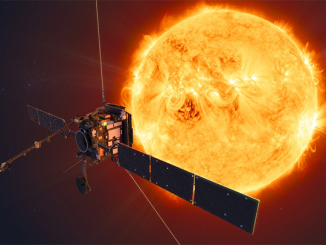Three companies based in the Los Angeles area — Virgin Hyperloop One, Hyperloop Transportation Technologies and Elon Musk’s The Boring Company — are locked in a a globetrotting whirlwind competition to develop magnetic-levitation transportation systems.

Musk’s The Boring Company which is a subsidiary of SpaceX in nearby Hawthorne, CA, is moving ahead on its proposals to tunnel under transportation corridors in Los Angeles, Chicago and the East Coast where its “electric skates” would carry passengers smoothly levitated at high speed. In May the company showed glimpses of a test tunnel that it has been digging underneath its property at SpaceX.
It is still years away before a paying passenger might climb aboard for a ride on any of the systems, if it were to successfully launch at all, but the pace of development proposals, testing and prototype unveilings has the companies and a flurry of government entities around the world looking at daunting infrastructure proposals while thinking in new ways about magnetism.
As for the pods, HyperloopTT envisions 100-foot-long models fitted with video screens that would recreate the scenery outside, capable of seating 40 passengers. Virgin Hyperloop One champions the use of pods fitted with leather seats and armrest-mounted entertainment screens as well as other pods configured for commercial shipping. It showed a prototype of its passenger pod recently in the Middle East. The virgin part ot the company’s name comes from transportation entrepreneur Richard Branson who became an investor and chairman of the company in 2017. Boring’s pods, termed electric skates by the company, would carry eight to 16 passengers.

In recent developments, Virgin Hyperloop One announced plans to open a European test facility in 2020, marking another significant advancement for the company. Since it posted record speed and performance results at its DevLoop test site in the U.S., the Los Angeles-based company has been aggressively pursuing feasibility programs in multiple countries including Spain, India and United Arab Emirates as well as the U.S.
Virgin Hyperloop One pod prototype
The speed record of approximately 240 miles per hour was achieved during its third phase of testing at DevLoop in December. The system achieved faster speeds and tested a new airlock which helps transition test pods between atmospheric and vacuum conditions during its latest test campaign. All components of the system were successfully tested including the airlock, electric motor, advanced controls and power electronics, custom magnetic levitation and guidance, pod suspension and the vacuum, the company reported. The tube was depressurized down to the equivalent air pressure experienced at 200,000 feet above sea level. The basic operation calls for a pod to quickly lift above the track using magnetic levitation and glide at airline speeds through a vacuum tube for long distances due to ultra-low aerodynamic drag.
In September the company reported that it signed an agreement with the state-owned Administration of Railway Infrastructures in Spain to open an Advanced Technology Development and Testing Center that would become Hyperloop One’s first European development facility, valued at approximately $500 million. In return for this investment, the company would obtain 126 million euros in public aid through loans and grants to help establish the new center, to advance Virgin Hyperloop One’s technology development and testing, and to stimulate regional economic growth and job creation, according to Rob Lloyd, CEO.
The 19,000 square meter center, planned to be opened by 2020, would develop, test, and certify components and subsystems to continually improve safety and reliability of hyperloop systems. “With its robust transportation, aerospace and high-tech sectors in turn paired with outstanding regional talent, Spain is an ideal fit for Virgin Hyperloop One’s Advanced Technology Development and Testing Center,” said Lloyd. “By investing in the development and testing of Virgin Hyperloop One, Spain is extending its long-tradition as an innovative, global transport leader. We are excited to partner with such a forward-thinking country in developing the next generation of transportation.”
The center is to be in the Andalusian region of Spain at Bobadilla, a village in the province of Malaga. With over 9,000 companies in transport and logistics, the second largest aerospace cluster in Spain, and 20,000 employees in R&D, the new center in Andalusia complements the advanced transportation, aerospace, and high-tech innovation in the Andalusian region and will be a catalyst for further economic growth. Virgin Hyperloop One estimates that it would hire 200-300 high-tech skilled professionals to staff it.
“The location of the center in our country will lead to important high-value commercial opportunities and will boost economic growth in the region,” said ADIF in a statement. “The agreement with Virgin Hyperloop One will help us to deepen the willingness to face new technological challenges, contributing to reinforce our leadership in the development of transport infrastructures in the international arena.”

In April, DP World and Virgin Hyperloop One introduced their concept for DP World Cargospeed, an international brand for hyperloop-enabled cargo systems for palletized cargo. Designed for high-priority, on-demand goods, the system would deliver freight at the speed of flight and closer to the cost of trucking. DP World, based in the UAE, is the largest investor in Virgin Hyperloop One. The company oversees a portfolio of 78 operating marine and inland terminals supported by over 50 related businesses in over 40 countries across six continents with 36,000 employees. Container handling is the company’s core business and generates more than three quarters of its revenue.
In February, the UAE Roads Transportation Authority unveiled prototype designs of Virgin Hyperloop One’s passenger system at the country’s UAE Innovation Month in Abu Dhabi. Designed with deluxe interiors and cutting-edge information and entertainment features, the capsules magnetically levitate slightly off their track within the tube and would be designed to reach a top speed of 1200 km/hour.

Accordingly, the system could travel between Dubai and Abu Dhabi in 12 minutes and lift about 10,000 passengers per hour in both directions. The pods would be designed to travel over short and medium distances on dedicated lanes. They could be pled in 15 to 20 seconds or detached, depending on the destination of riders, in 5 seconds. They would be fitted with cameras and electromechanical technologies to carry out the coupling and detaching processes. Each pod is designed to accommodate ten riders, six seated and four standing.
In India, Hyperloop One is working with government agencies on feasibility studies for a Pune-Mumbai hyperloop route. Envisioned as a passenger and cargo system, It would link central Pune, Navi Mumbai International Airport, and Mumbai in 25. In June, Hyperloop One reported that the study had reached its midpoint and would be completed soon. Meanwhile, the company has also announced feasibility studies in which it is engaged in the U.S.
For its part, HyperloopTT has also been moving on multiple fronts globally. In July, it announced the signing of an agreement in China with the Tongren Transportation & Tourism Investment Group. According to the company, it marked the first hyperloop agreement in the country became the company’s twelfth cooperative agreement for system study or proposal. Others have included various pacts in Ukraine, the U.S., Slovakia, in the Midast, Czech Republic, France, India, Indonesia, Brazil, Korea and the Mideast.
In October the company unveiled its concept for a full-size passenger capsule in Cadiz, Spain. The capsule measures 105 feet long, would weigh five tons and carry 28 to 40 passengers. Plans called for the capsule next to be moved to its research and development center in Toulouse, France, to finish assembly and run tests on a full-size track. It was built at the southern Spain aerospace facility of its partner Airtificial.
Their system envisions the capability for capsule departures every forty seconds and a maximum speed of 1,223 km/hr, able to move 164,000 passengers a day on one line at full efficiency. It calls its magnetic levitation system, “Inductrack.” Magnets arranged in a Halbach array configuration enable passive levitation over an unpowered but conductive track. As capsules move through the low pressure environment, they use very little energy on route thanks to the reduced drag forces.
For information about the companies, see www.BoringCompany.com, www.Hyperloop-One.com and www.Hyperloop.global.



